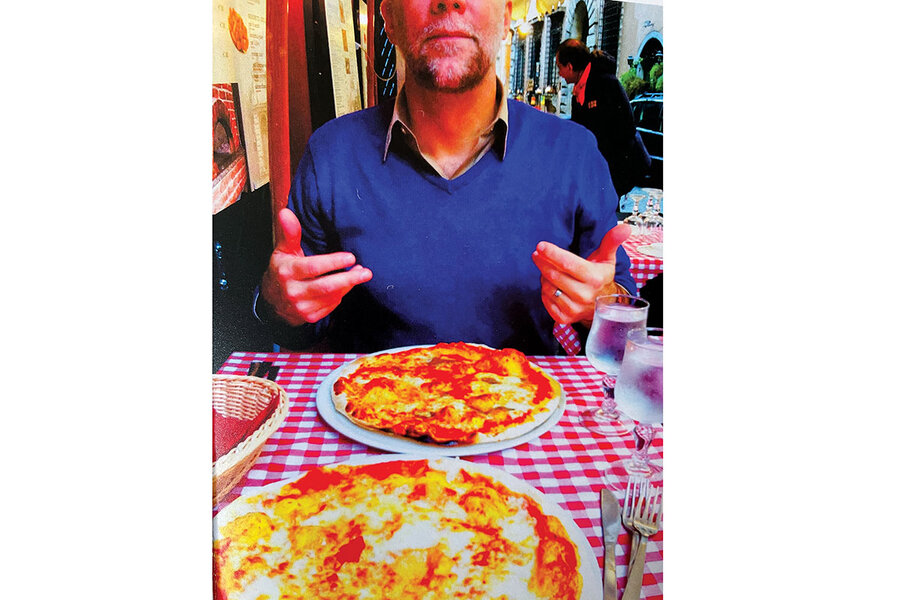A hot, tomato-and-cheese solution to anguish
Loading...
Pizza! It garners almost universal enthusiasm as a respite from Friday night cooking, an affordable meal on the fly, or a way to grease the skids of a dreaded business meeting. But I was unaware of its therapeutic value until I had kids.
I adopted my older son, Alyosha, in Russia when he was 7. I was a single parent, and we had a good start. But when he was 8, something – I don’t recall what – didn’t go his way, and he announced, “I go back Russia.”
Why We Wrote This
A story focused onSolace can be offered, but it must be embraced. Sometimes, comfort is best served atop something hot and cheesy.
I watched as he walked out the door. I caught up and walked alongside him down the street.
“It’s far,” I told him.
Staring straight ahead, Alyosha replied, “I don’t care. I walk.”
I added, “There’s an ocean between here and Russia.”
Alyosha didn’t miss a beat. His response: “I take boat.”
I took aim at his heart. “I’ll miss you,” I said.
Alyosha plodded on but replied, “I miss you too.”
Finally, after a long stretch, I suggested, “How about pizza?”
His response: “OK.”
And that was that. He never made it to Russia.
To appropriate a well-worked adage, a slice of pizza is sometimes worth a thousand words of consolation.
Pizza!
There have been many paeans to a dish that garners almost universal enthusiasm, whether it’s as a respite from Friday night cooking, an affordable meal to eat on the fly, or a ready way to grease the skids of a dreaded business meeting.
For me, I was unaware of pizza’s therapeutic value until I had kids.
Why We Wrote This
A story focused onSolace can be offered, but it must be embraced. Sometimes, comfort is best served atop something hot and cheesy.
When my boys were still growing, most situations were easily addressed: If you don’t pick up your room, you can’t go out to play. But there were also moments when the solution wasn’t evident to me, and as a single parent, there was no other adult in the house to consult.
I adopted my older son, Alyosha, in Russia when he was 7. We had a good start. But one day, when he was 8, something – I have long since forgotten what – didn’t go his way. He was still getting English under his belt, and, having not prevailed in the matter, he announced, “I go back Russia.”
I looked on as he walked out the door. Then I caught up and walked alongside him as he made his way down the street.
“It’s far,” I told him.
Staring straight ahead, he replied, “I don’t care. I walk.”
We continued on, and I added, “There’s an ocean between here and Russia.”
Alyosha didn’t miss a beat. His response: “I take boat.”
I finally aimed for the heart: “I’ll miss you.”
Alyosha plodded on but replied, “I miss you too.”
Finally, after a long stretch, I suggested, “How about pizza?”
His response: “OK.”
And that was that. He never made it to Russia.
When my second son came along, adopted from a Ukrainian orphanage at the age of 5, the waters of his life with me were roiled in his sixth year, when he became enamored with a 5-year-old girl in a neighbor’s family. One cold, dark evening, he took to his heels, intent on visiting Diana against my wishes. I had quite a time locating him, but I eventually found him standing on a traffic island, tears coursing down his cheeks because he couldn’t figure out how to navigate the crossing. I threw a jacket around him and gathered him into my arms.
“How about pizza?” He wiped his tears on his sleeve and sniffed, “OK.”
A short while later the ardor of his love was being attenuated by the sweet taste of pepperoni nestled within a double-cheese crust.
Both of these adventures suggested the enduring value of what I call “the pizza cure.” Its beauty lies in its simplicity. I have observed that, confronted with a variety of exotic toppings – I recently noted kale, chard, and pineapple pizza with caramelized onions – most people will still choose a slice of plain cheese pizza. It is time-tested, familiar, unpretentious. And it has proved to be a balm for an assortment of maladies, beyond rescuing children from the perils of a trek to Russia or the devastation of unrequited love. By way of example, one of my students recently confided a minor personal crisis to me. Nothing I said could pull him out of his slough of despondency, and so I acted. I took him to a local pizza joint and watched as he tucked into a magazine-size slice of double cheese, double crust. Moments later the clouds had parted and the light of alleviation shone through. The world once again seemed manageable.
To appropriate a well-worked adage, a slice of pizza is sometimes worth a thousand words of consolation.







